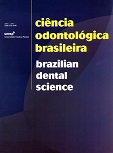Avaliação radiográfica de retentores intra-radiculares metálicos fundidos
DOI:
https://doi.org/10.14295/bds.2004.v7i4.240Abstract
A confecção de retentores intra-radiculares metálicos fundidos é de fundamental importância para a longevidade do tratamento protético restaurador. A mesma pode se tornar crítica, se não observados princípios fundamentais, podendo se tornar causa de insucessos. O propósito neste trabalho foi avaliar radiograficamente a situação clínica de retentores intra-radiculares metálicos fundidos, e a coerência dos mesmos com os princípios para sua confecção. Para tal, 447 radiografias de dentes uniradiculados portadores de retentores intra-radiculares fundidos foram selecionadas a partir do arquivo da Faculdade de Odontologia de São José dos Campos e de consultórios particulares da cidade de São Paulo. As mesmas foram escaneadas, e analisadas no software para medições Image Tool for Windows 1.28, a partir de medidas pré-estabelecidas. Estes valores obtidos foram tabulados e, a partir de fórmulas matemáticas, foram verificados cinco fundamentos necessários à classificação de um tratamento como aceitável: regra dos dois terços, espaço vazio entre material obturador e porção mais apical do retentor, quantidade de material obturador remanescente, distância do material obturador ao ápice dentário e regra do fulcro dentário. Foram convencionados os parâmetros para classificar como aceitáveis ou não, verificando prevalência para todas as classes analisadas. Foram considerados inaceitáveis os fatores: comprimento do retentor intra-radicular, espaço entre retentor e material obturador, quantidade de raiz não obturada e comprimento do retentor em relação à implantação óssea da raiz. Apenas o material obturador remanescente foi considerado como aceitável dentre a população analisada neste estudo. Conclui-se que maior cuidado deve ser tomado na realização de retentores intra-radiculares pós-tratamento endodôntico.Downloads
Downloads
Published
How to Cite
Issue
Section
License
Brazilian Dental Science uses the Creative Commons (CC-BY 4.0) license, thus preserving the integrity of articles in an open access environment. The journal allows the author to retain publishing rights without restrictions.
=================




























